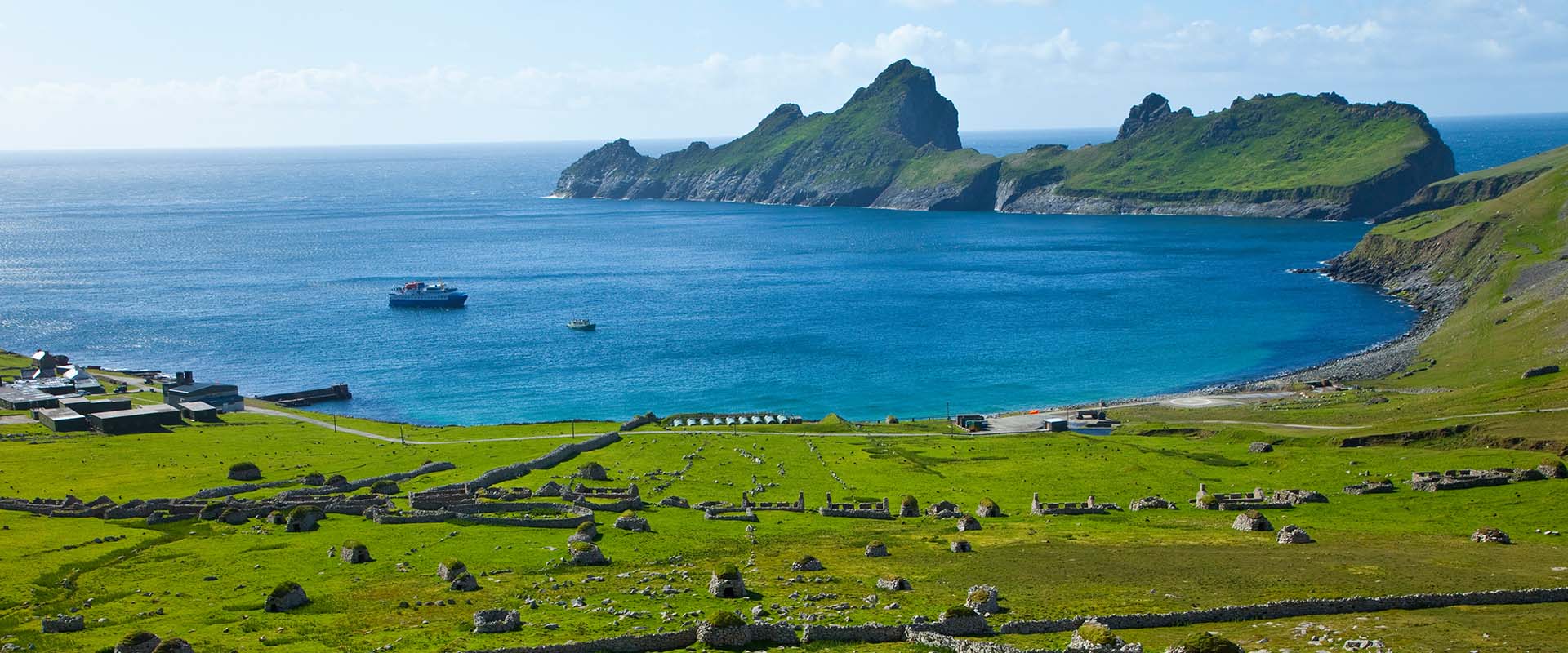Adventure Cruises in Outer Hebrides
Outer Hebrides Cruise trips sweep guests into the magical world of the Western Isles, an island chain west of Scotland. A part of the greater island cluster, the Hebrides, Outer Hebrides, is separated from the Scottish mainland and the Inner Hebrides by the Minch, the Little Minch, and the Sea of the Hebrides.
Cruises to the Outer Hebrides, Scotland, stop regularly at many of the 15 islands in the chain, all of which are bedrock formed of metamorphic rock. Small ships cruising around Scotland commonly include a spin along the Outer Hebrides.
The civilization dates back to the Roman and Greek empires. After that, the Hebrides were absorbed by the Norse kingdom of Suðreyjar until Scotland received sovereignty in 1266 under the Treaty of Perth.
Top things to do and see on an Outer Hebrides Island Cruise
What's in store for you on your Hebridean cruise to the Western Isles of Scotland? Your itinerary will include some of the following sights and activities.
The Isle of Barra is the second most Southerly inhabited island in the Outer Hebrides cluster. It is known for its beautiful beaches and plentiful wildlife, including seven lochs for brown and sea trout fishing. Visit the highest hill in Barra, Heaval, see the ancient Cille Bharra graveyard, and if your itinerary begins here, fly into the famous Barra airport. You land right on the sand.
The Isle of Eriskay is the home of the Eriskay ponies – a hardy Hebridean breed of small horses. There are only 400 or so left on the whole planet, so this is not a sight to take lightly. It is also known for its strikingly colorful landscape. It's a photographer's dream. It is also favored by birders who want to catch a glimpse of the corncrakes, short-eared owls, hen harriers, and otters.
The Isle of Harris is full of wildlife, from hares to common porpoises, common seals, and many species of birds. An incredible Bird of Prey Trail is at the North Harris Eagle Observatory. The island is full of mountains, making for a visually interesting terrain for photographing the animals you spot.
The Isle of Lewis is the northern part of Harris and Lewis. In contrast to Harris, Lewis is flat, and the sandy beaches are plentiful. See the standing stones called Calanais (Callanish) and fish, cycle, take a nature walk, or do some bird watching.
The Shiant Isles are home to Britain's oldest Puffin and are a wonderful place for birdwatching. It's also an excellent site for whale tours among the impressive sea cliffs.
St. Kilda also has incredible sea cliffs and extremely important seabird breeding locations. The island is volcanic, which lends a special feel to its environment. You can see fulmar, guillemot, and gannets, historic cottages in the village, and the local church, schoolroom, and museum.
The Uists are known for their wild landscapes, white beaches, and a sense of peace and tranquility. Music is a big deal in The Uists. Take a performance at the Claddach Kirkibost Community Center, Taigh Chearsabhagh Museum and Arts Centre, and Kildonan Museum, and see the exhibits there. Also, there are otters here; keep an eye out!
Speedboat rides, fishing trips, and cycling are popular activities on many of the islands in the Outer Hebrides. Use a bike to traverse the landscape, turn your trek into a photography cruise, and stop to sample local foods and crafts.
Other common wildlife species you may see in your travels are white-tailed eagles, majestic golden eagles, comical puffins, graceful manx shearwaters, playful otters, dolphins, whales, porpoises, and seals.
Top Tips for visiting the Outer Hebrides on a cruise
The biggest tips for enjoying your experience on a small ship cruising around Scotland are:
- Bring clothing you can layer- the temperatures can vary and border on chilly.
- Don't forget your binoculars or camera for shots of the landscape, the beautiful colors of the vegetation, and the animal sightings you're sure to have.
- We always recommend a dry bag to help protect your electronics on trips to and from shore.
- Bug repellant for the midges is key to enjoying your outdoor activities unless you’re traveling in the winter.
- Comfortable shoes are essential when you set out to see monuments and wildlife or walk along the beaches.
Best time to cruise the Outer Hebrides Islands
If you can plan to make the most out of your time in Scotland, the best time to take an Outer Hebrides Cruise may be July. The weather is most likely lovely, and you can see many seabirds in various stages of development. Average daytime temperatures reach 16 degrees Celsius.
Some warn against visiting the islands from April 10 to May because the sheep are lambing, and it's best to leave the ewes undisturbed.
It's riskiest to take your Outer Hebrides Cruise in October through March, but there is still good weather to be had then. Remember that the later it gets in the year, the earlier it gets dark, and temperatures can drop to nearly 0 degrees Celsius.
Spring and autumn months see temperatures between 8 to 12 degrees Celsius.
Where do Outer Hebrides cruises depart from?
Make your way to Glasgow airport on the mainland of Scotland, and you're nearly ready to begin your adventure in the Outer Hebrides. Your Scottish small-ship cruise will usually include complimentary assistance from the airport to your departure point on Oban, Tobermory, Inverness, or Kyle of Lochalsh.
Each itinerary will be different, so please check yours for specific details and contact us with any questions about your travel.











